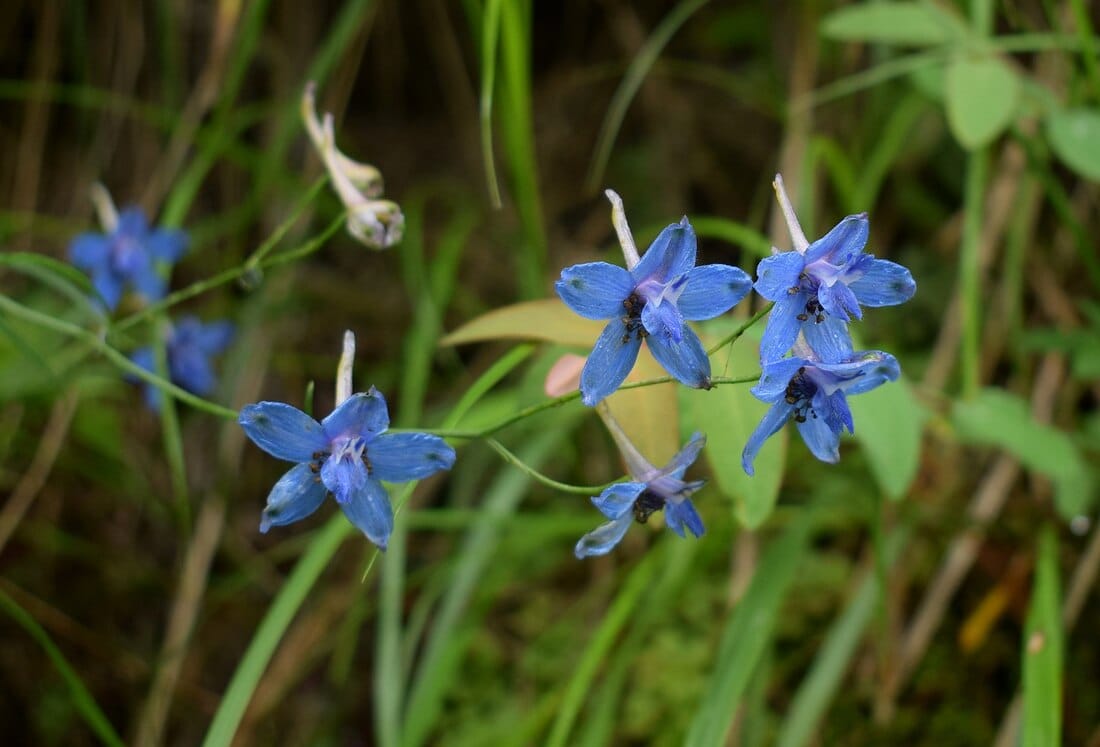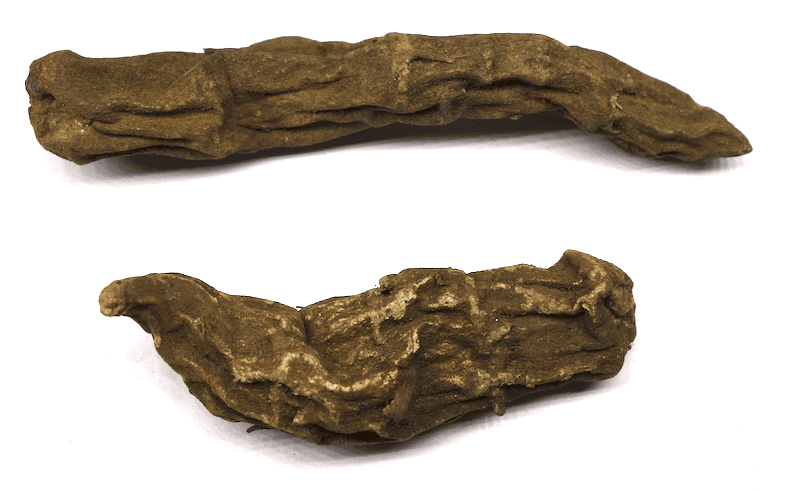Delphinium denudatumNirvisha (Ayurveda)Jadwar (Unani) |

|
 Delphinium denudatum flower
Delphinium denudatum flower(Photo by Delonix, edited) (Wikimedia)
 Delphinium denudatum root
Delphinium denudatum root(Calcutta Unani College, Adam, 2019)
Botanical name:
Delphinium denudatum (syn. D. pauciflorum)
Some classical Unani texts differentiate between 4 types of Jadwar: White, Violet, Black and Yellow. Other sources have described 5 types, given in order of preference they are:
1. Black externally, reddish violet internally; sweet then bitter
2. Yellow-Black inside and out: bitter
3. Black inside and out; bitter
4. Black, olive-sized and bitter
5. Black, long and bitter, found growing in Spain, and near Aconite.
Black and Violet types are regarded as best.
This is similar to the 4 color variations of Aconite realised in Tibetan Medicine. One of the 4 types of Tibetan Aconite is thought to be a species of Delphinium. The Delphiniums and Aconites have similar leaves and are often found growing together.
Parts used:
Root
Temperature & Taste:
Very Warm, dry. Bitter. Toxic
Classifications:
3B. FEBRIFUGE & ANTIPYRETIC
4j. NERVINE
Uses:
1. Benefits Yang, Clears Cold: (Ayurveda, Unani)
–a tonic for the Vital Organs (Heart, Liver, Brain and Kidneys)
-Aphrodisiac, for Impotence, Male Infertility, Spermatorrhea.
-Lumbago, chronic Joint diseases including Rheumatism.
-chronic urinary diseases including Dysuria; also to help with Stones
-general body tonic in weakness, fatigue and chronic illness.
2. Stops Wind, Benefits the Mind and Nerves: (Ayurveda, Unani)
–benefits and strengthens the Nervous System
-Paralysis, Convulsions, Epilepsy, Migraine, various Neuralgias, Numbness and Tremors
-Muscular Atrophy
-enhances Memory.
-classed an an Exhilarant in Unani and has been used for Depression and Neurasthenia.
-Opiate addiction
3. Resists Poison: (Ayurveda, Unani)
-bites of Poison Insects, Snakes and Scorpions
-“an Antidote against all Snake Venoms and Aconite Poisons” (Avicenna)
-protective against Epidemics including Plague, Cholera and Influenza
-Syphilis
-helps reduce Fevers, especially from Phlegm or Melancholy humor.-Aconite poisoning: after vomiting, the root is given with Milk (Unani); considered Specific-traditionally used against Opium addiction
4. Moves the Blood, Eases Pain:
–Inflammation and Pain of the Soft Tissues and Joints
-stimulates the Heart and benefits Circulation.
-helps with Menstrual disorders associated with pain and Blood stagnation
-Wounds and Trauma.
-said to improve complexion.
5. Warms the Stomach, Benefits the Digestion:
–indigestion, poor appetite and other abdominal diseases with bloating, wind and pain with Cold and Phlegm.
6. Externally:
-applied topically to Leucoderma, Vitiligo, Freckles and Acne
-root is chewed for Toothache
-applied to painful Piles
-reportedly a good application to Muscular Atrophy
-applied to glandular swellings
-the paste is applied to Inflammations, Wounds, Skin irritations and Pains
-paste is also applied to toxic bites including Scorpion and Snake Bites.
-it has been used externally for parasites including Lice.
Dose:
Powder: 500mg–1 gram
Comment:
The Delphiniums are similar in appearance to the Aconites, and are often found growing in similar areas. Both contain Diterpene Alkaloids and both are toxic, although the Aconites are generally far more toxic.
Correctives:
Fresh Milk; Barley water (Unani)
Substitutes:
1. Zerumbet (Unani)
2. Long Zedoary in triple the dose (Avicenna)
3. Similar to the actions of Doronicum”. (Avicenna)
Adulterants:
This root is frequently adulterated. False roots are often described as rough, uneven and shriveled, and are usually slightly acrid, rather than intensely bitter. Genuine root is smooth and clear, and very bitter. Aconite roots are often admixed; they are sweet, then bitter and tingling, while genuine Delphinium is bitter. Delphinium root itself is used to adulterate Aconitum heterophyllum (Atis).
Main Combinations:
1. To calm the Mind and Nerves, and settle Wind, Delphinium denudatum with Aloeswood, Peony, Nutmeg, Tabasheer, Pearl (as in Hab-e-Amber Momyaie, or Pills of Ambergris of Unani)
2. To benefit the Heart, calm the Mind and Nerves, Delphinium denudatum with Silkworm Cocoon, Nutmeg, Saffron, Aloeswood, Red Coral, Pearl, Amber (as in Hab-e-Jawahir of Unani)
3. Fatigue, Delphinium denudatum with Amaranthus spinosa
4. To protect from the Plague and Infectious diseases, Delphinium denudatum with Camphor and Doronicum (Unani)
Major Formulas:
Khamira Jadwari
Khamira Gaozaban Jadwari
Hab-e-Jadwar
Hab-e-Jawahir
Hab-e-Amber Momyaie
Marham Jadawar
Cautions:
The plant is toxic, especially when young. Avoid overdose.
Toxicity:
Despite the fact that the active ingredients are potentially toxic, poisoning in humans has never been reported (PDR).
Main Preparations used:
-
Extra Info
- History
-
Research
|
‘The history of this drug is beset with many difficulties, on account of the vague meaning of the term Jadwar; the name by which it is generally known, and which appears properly to mean zedoary. Under Jadwar, the author of the Makhzan-el-Adwiya gives Antila as the Arabic name, and Saturyus as the Greek. Speaking of Bish he says that the Hindus suppose that the only plant which can grow near it is the Jadwar, which is an antidote to it, and that they also affirm that there is a kind of rat, called ‘Bish mush bisha,’ which lives upon Jadwar, and is an antidote to Bish; this is the Btika Bish Mush of Ibn Sina [Avicenna]. The Indian name Nirbishi he explains incorrectly as Nir, the antidote to, Bish, the poison; he describes five kinds:— 1st— Khatai, black externally, purplish brown internally, scorpioid, knotted, tasting sweetish at first, afterwards very bitter. 2nd— Outside and inside brown, or yellowish brown. 3rd— Outside and inside black;when rubbed down it has a purplish tinge, bitter. This and the second kind come from Thibet, Nipal, Morang and Rangpore. 4th— Blackish, bitter, size of an olive, comes from the Deccan hills. 5th— Spanish, called Antila, black, soft, very bitter. Of these the first kind is said to be most esteemed. It |
would appear, then, that the term Jadwar has at different times been applied to various tuberous roots supposed to have alexipharmic properties, and that in India it is, at present, applied to the root of a Delphinium, known to the Hindus as Nirbishi, a term which, like Jadwar, has at different times been applied to very different plants. Royle tells us that the best Nirbisi is brought down from Bissehar and Amritsar, and is fusiform, and resembles Bikh, when cut it is of a brownish colour and slightly bitter and acrid. Ulasr Muharrir says that false Jadwar is prepared by boiling the roots of some of the milder kinds of Bish in milk, and colouring them; it is to be distinguished from genuine by its parting with its colour when dipped in warm water and wiped with a cloth; it has also a shrivelled appearance, and the central portion to which the colour has not penetrated is pale ; instead of being intensely bitter, it is slightly acrid. Native Medical works abound in absurd stories concerning this article, and its wonderful power as a tonic and alexipharmic ; it fetches a high price, and is generally kept in metallic mercury to prevent its being injured by worms; sometimes it is preserved in oil’. (Vegetable Materia Medica of India, Dymock, 1885) |
COVID:
–Potential of Natural Alkaloids From Jadwar (Delphinium denudatum) as Inhibitors Against Main Protease of COVID-19: A Molecular Modeling Approach.
ANTIFUNGAL
–Antifungal diterpenoid alkaloids from Delphinium denudatum.
FATIGUE
–The effect of Delphinium denudatum (Jadwar) on fatigue: A randomized double blind placebo-controlled clinical trial.
ANXIETY
–In Vivo Psychopharmacological Investigation of Delphinium Denudatum and Amaranthus Spinosus Extracts on Wistar Rats.
ANTICONVULSANT
–A novel anticonvulsant modulates voltage-gated sodium channel inactivation and prevents kindling-induced seizures.
–Anticonvulsant effect of FS-1 subfraction isolated from roots of Delphinim denudatum on hippocampal pyramidal neurons.
–In vitro inhibition of pentylenetetrazole and bicuculline-induced epileptiform activity in rat hippocampal pyramidal neurons by aqueous fraction isolated from Delphinium denudatum.
–Anticonvulsant activities of ethanolic extract and aqueous fraction isolated from Delphinium denudatum.
–Anticonvulsant activities of the FS-1 subfraction isolated from roots of Delphinium denudatum.
DEMENTIA & ALZHEIMER’S DISEASE
–Norditerpenoid alkaloids of Delphinium denudatum as cholinesterase inhibitors.
–Isolation, crystal structure determination and cholinesterase inhibitory potential of isotalatizidine hydrate from Delphinium denudatum.
PARKINSON’S DISEASE
–Protective effects of ethanolic extract of Delphinium denudatum in a rat model of Parkinson’s disease.
OPIATE ADDICTION
–Effect of roots aqueous extract of Delphinium denudatum on morphine-induced tolerance in mice.
–Experimental study of the morphine de-addiction properties of Delphinium denudatum Wall.
–Protective role of Delphinium denudatum (Jadwar) against morphine induced tolerance and dependence in mice.
